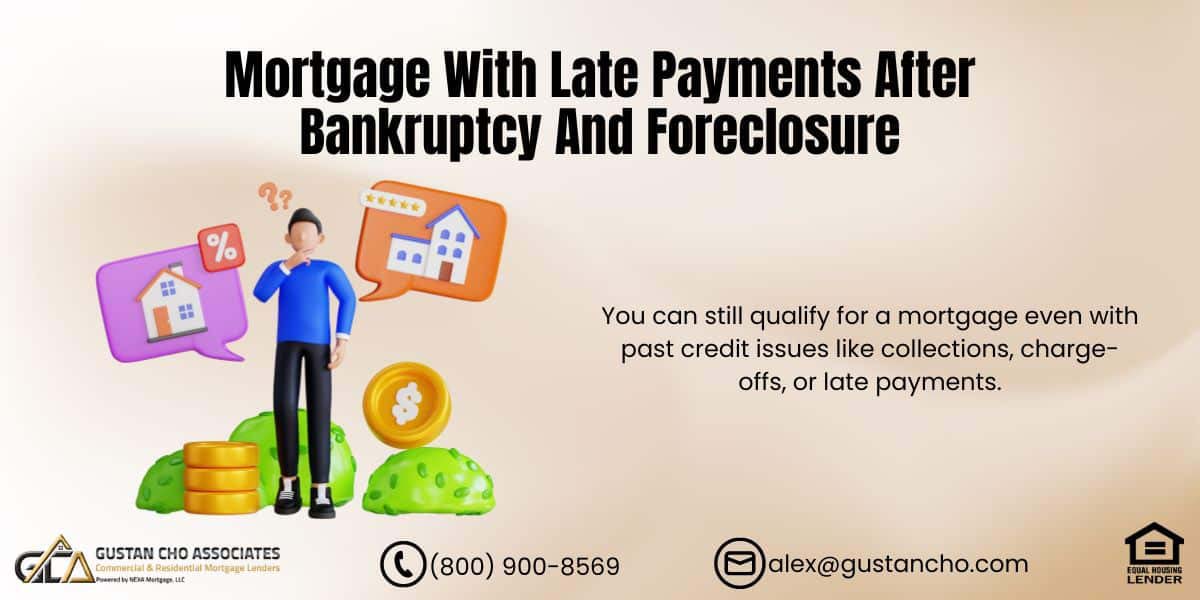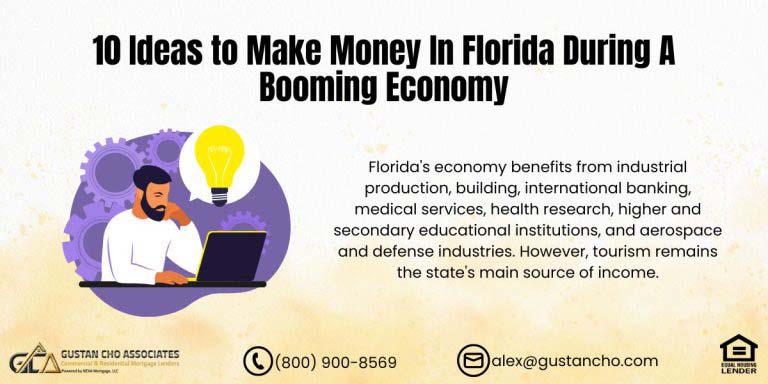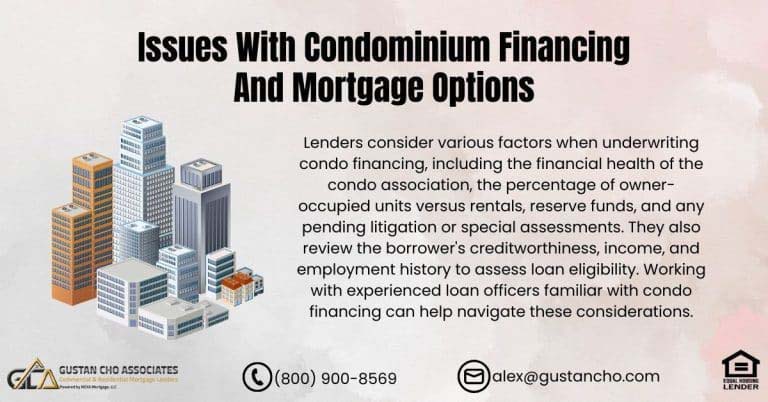Home loans are still available to borrowers with collections, charged-off accounts, or late payments. Lenders are generally willing to approve applicants with a history of bad credit, bankruptcy, foreclosure, a deed instead of foreclosure, a short sale, or a period of financial hardship. However, lenders expect borrowers to have rebuilt their credit following any previous issues.
You can still qualify for a mortgage with late payments after bankruptcy or other housing events. Despite this, minimum waiting periods to qualify for a mortgage after bankruptcy or a housing event vary by loan program.
It’s important to understand that simply passing the mandatory waiting period after bankruptcy, foreclosure, deed instead of foreclosure, or short sale does not guarantee mortgage approval. Lenders will want evidence that borrowers have worked to reestablish their credit responsibly. While no late payments are ideal after bankruptcy and foreclosure, one or two late payments may not necessarily be a dealbreaker.
Can I Qualify For A Mortgage With Late Payments After Bankruptcy And Foreclosure With An AUS Approval
Lenders generally frown upon late payments after bankruptcy and foreclosure, often viewing borrowers with such a history as “second offenders.” This term suggests that these applicants are seen as financially irresponsible, prone to habitually missing payments, and therefore considered a high credit risk.
It is possible to achieve an “approve/eligible” status through the automated underwriting system (AUS), even if you have had one or two late payments after a bankruptcy or foreclosure. Despite common belief, this is achievable. However, many lenders will not accept these applicants even with AUS approval due to their lender overlays.
Gustan Cho Associates stands apart from most lenders by not imposing overlays on late payments after bankruptcy or housing events. You can secure an approve/eligible rating through the automated underwriting system. Gustan Cho Associates will approve and close your home mortgage in that case, as they have no lender overlays. This option is viable for those seeking a mortgage with late payments after bankruptcy.
Late Payments, Bankruptcy, and Foreclosure Don’t Have to Stand in the Way of Your Home!
Reach out now to find out how we can help you get the home loan you need.
Importance Of Timely Payments And Payment History After Period Of Bad Credit
Borrowers are not required to pay off outstanding collections and charged-off accounts to be eligible for home loans. Lenders will typically require a consistent record of 12 months of on-time payments. The Automated Underwriting System (AUS) only approves borrowers demonstrating this recent, reliable payment history.
While securing an AUS approval with one or two late payments in the past year is possible, qualifying for a mortgage with late payments after bankruptcy and/or a housing event is more challenging.
Though it’s not impossible to obtain an AUS approval for a mortgage with late payments after bankruptcy and/or foreclosure, most lenders remain hesitant to approve these borrowers due to their internal overlays. However, Gustan Cho Associates, a nationwide mortgage company licensed in multiple states, overlooks government and conventional loans. With AUS approval, they can fund loans even if you have late payments after bankruptcy and/or foreclosure.
Their zero-overlays policy on government and conventional loans makes them a potential solution for borrowers seeking a mortgage with late payments after bankruptcy.
Qualifying For Mortgage After Bankruptcy And Foreclosure
A Chapter 7 Bankruptcy is a federal law designed to help individuals eliminate most of their debts and reset their financial lives. This type of bankruptcy allows consumers to discharge obligations like credit card debt, judgments, installment loans, personal loans, and other non-government liabilities.
Debts like federal student loans, cannot be discharged through Chapter 7. This form of debt relief is particularly beneficial for consumers overwhelmed by financial burdens due to unemployment, business failure, divorce, medical issues, or other circumstances.
After completing the Chapter 7 process, all eligible debts are wiped out, giving the debtor a fresh start without outstanding financial obligations. It’s an effective option for people seeking a mortgage with late payments after bankruptcy to rebuild their finances and credit history.
Debts That Cannot Be Discharged In Bankruptcy
There are certain debts that cannot be discharged through a Chapter 7 Bankruptcy such as the following:
- student loans
- government loans
- child support payments
- tax debts
- tax liens
- Once a debt from a creditor is discharged through bankruptcy, the consumer no longer owes the debt
- They are no longer responsible to pay that debt
- All unsatisfied judgments also get discharged
- Consumers do not have to worry about getting any future collection activities from the judgment creditor such as wage garnishments, bank levy, or have liens placed on their assets
- Homebuyers can qualify for Mortgage With Late Payments After Bankruptcy and foreclosure after meeting the waiting period requirements
- However, late payments after bankruptcy and foreclosure are often frowned upon by all lenders
Late payments after bankruptcy can be deal killers in getting qualified for home loans after bankruptcy.
Ready for a Mortgage After Late Payments, Bankruptcy, and Foreclosure? We’ll Help You Get Approved!
Reach out today to discuss your options and see how we can help you get a mortgage after late payments, bankruptcy, or foreclosure.
Qualifying For Home Loan After Bankruptcy
People can definitely get a home loan after bankruptcy and the majority of folks who filed bankruptcy eventually have become homeowners in as little as two years from their bankruptcy discharged date with FHA and VA Home Loans:
- One of the major issues where getting a home loan after bankruptcy becomes a major issue is if borrowers had late payments after bankruptcy
- It is possible to qualify for Mortgage With Late Payments After Bankruptcy and Foreclosure
Most mortgage companies will disqualify applicants who had late payments after bankruptcy and foreclosure as well as those with late payments after a short sale.
What Happens if You Make a Late Payment on a Mortgage?
Late payments after bankruptcy and housing events are not deal killers. However, making a late payment on a mortgage can have several consequences, depending on the timing and frequency of the lateness:
- Grace Period: Many mortgage contracts have a grace period, usually around 10 to 15 days after the due date. If you pay within this period, it usually won’t be considered late, and you won’t incur late fees.
- Late Fees: After the grace period has elapsed, lenders typically impose a late fee of 3% to 6% of the overdue payment. It’s important to note that these fees may differ based on the terms of your loan.
- Credit Impact: If your payment is more than 30 days late, the lender may report it to the credit bureaus. Your credit score will likely be negatively affected by this, which will continue to be reflected in your credit report for 7 years.
- Repeated Late Payments: Missing payments or paying late on multiple occasions can escalate the chances of foreclosure. Paying your bills past their due date can increase interest rates and fees if you apply for additional credit.
- Foreclosure: If payments remain unpaid and the delinquency becomes severe, the lender might start foreclosure, which can result in you losing your home.
Lenders are more than happy to lend on borrowers with prior bankruptcies but not late payments after bankruptcy and/or housing events. Lenders do expect that they do not have any late payments after bankruptcy. Lenders want to see re-established credit after bankruptcy and foreclosure and steady employment.
Just because borrowers have good credit scores after bankruptcy and foreclosure does not meet the credit criteria. Credit history and payment history after bankruptcy and foreclosure will carefully be analyzed and reviewed as well.
Will Late Payments be Removed After Bankruptcy?
In the United States, filing for bankruptcy can provide financial relief. Still, it does not automatically remove late payments from your credit report. Here’s what typically happens:
- Chapter 7 Bankruptcy: If your debt is discharged under Chapter 7, the late payments will not be removed from your credit report. However, those accounts will be marked as “discharged in bankruptcy.” This notation indicates that the debt was included in your bankruptcy and will remain on your report for up to 10 years from the bankruptcy filing date.
- Chapter 13 Bankruptcy: Under Chapter 13, you work out a 3- to 5-year repayment plan. Late payments before the bankruptcy filing will remain, but accounts will be marked to show they are part of a repayment plan. This bankruptcy remains on your credit report for up to 7 years after filing.
Late payments are part of your credit history. Past-due accounts can appear on your credit report for seven years, starting from the initial delinquency date. Consider checking with your bankruptcy attorney or credit reporting agency for more specific guidance based on your circumstances.
Can You Still Get a Mortgage with Missed Payments?
Yes, getting a mortgage is possible despite having missed payments in the past, but securing approval can be more challenging, and the terms may need to be more favorable. Missed payments often hurt your credit score, making lenders view you as a higher-risk borrower.
Lenders may demand a larger down payment or higher interest rates to offset risk. Recent missed payments have more impact than older ones. Explaining a medical emergency or job loss could help your application.
Some mortgage types, like FHA loans, are designed for individuals with less-than-perfect credit. Still, their qualification requirements tend to be more stringent. Every lender has different criteria, so shopping around or working with a mortgage broker could lead you to one willing to approve your application.
In the meantime, improving your credit score by paying off outstanding debts and consistently making on-time payments can help increase your chances of approval. If you’re concerned about your financial situation, consulting a financial advisor or mortgage specialist could provide useful strategies for repairing your credit and finding the right lender.
Denied For Mortgage With Late Payments After Bankruptcy And Foreclosure
I have many calls from borrowers who are told by lenders that they do not qualify for a home loan and will never qualify for a home loan because they had late payments after bankruptcy and foreclosure. Many lenders will not budge on this rule. They will automatically disqualify borrowers who had late payments after bankruptcy and foreclosure.
However, there are solutions to overcome this major issue. I have helped countless borrowers with late payments after bankruptcy and foreclosure.
If told that you do not qualify for a mortgage due to late payments after Bankruptcy and Foreclosure, please contact us at Gustan Cho Associates at 800-900-8569 or text us for a faster response. Or email us at gcho@gustancho.com so I review the overall credit profile and see if we can come up with a solution that will fit and suit the credit profile and implement them so we can qualify for a home loan.
Frequently Asked Questions: Mortgage With Late Payments After Bankruptcy And Foreclosure
- Can I qualify for a mortgage if I have past collections, charge-offs, or late payments? You can still qualify for a mortgage even with past credit issues like collections, charge-offs, or late payments. Borrowers who have faced credit issues such as bankruptcy, foreclosure, or short sale can still get approval from lenders, given that they have taken steps to rebuild their credit.
- Are there waiting periods for mortgages after bankruptcy or foreclosure? Yes, waiting periods vary by loan program. The required period begins after the bankruptcy or housing event is finalized. However, passing the waiting period does not automatically mean qualification; lenders will review your credit history to see if you’ve re-established credit responsibly.
- Will late payments be removed from my credit report after bankruptcy? No, late payments are not automatically removed. In Chapter 7 bankruptcy, late payments will be marked as “discharged in bankruptcy” but remain on your report for up to 10 years. For Chapter 13, late payments before filing remain on your report but are marked as part of a repayment plan and stay for up to 7 years.
- What happens if I have late payments on a mortgage after bankruptcy or foreclosure? Lenders generally frown upon late payments after bankruptcy or foreclosure. They may consider applicants with such a history to be at higher risk and might reject their application. However, some lenders, like Gustan Cho Associates, have no overlays and may approve borrowers who receive Automated Underwriting System (AUS) approval, even if they have one or two late payments.
- How can I improve my chances of qualifying for a mortgage? Rebuilding your credit is crucial. Ensure a consistent 12-month history of on-time payments. Although some late payments might still qualify for an AUS approval, working to pay off outstanding debts and maintaining a steady employment record will enhance your credibility.
- Do I need to pay off all collections and charge-offs to qualify for a mortgage? Not necessarily. Lenders often do not require the settlement of old collections and charge-offs to approve a loan. However, they will expect you to have a recent, timely payment history.
- What should I do if denied a mortgage due to late payments after bankruptcy or foreclosure? If denied, consider contacting mortgage specialists like Gustan Cho Associates, who work with borrowers facing these challenges. They can provide solutions tailored to your situation and guide you in improving your credit profile to qualify for a mortgage.
This blog about Mortgage With Late Payments After Bankruptcy And Foreclosure was updated on May 8th, 2024.
Had Late Payments After Bankruptcy and Foreclosure? We Can Help You Qualify for a Mortgage!
Contact us today to explore your mortgage options and get pre-approved.









